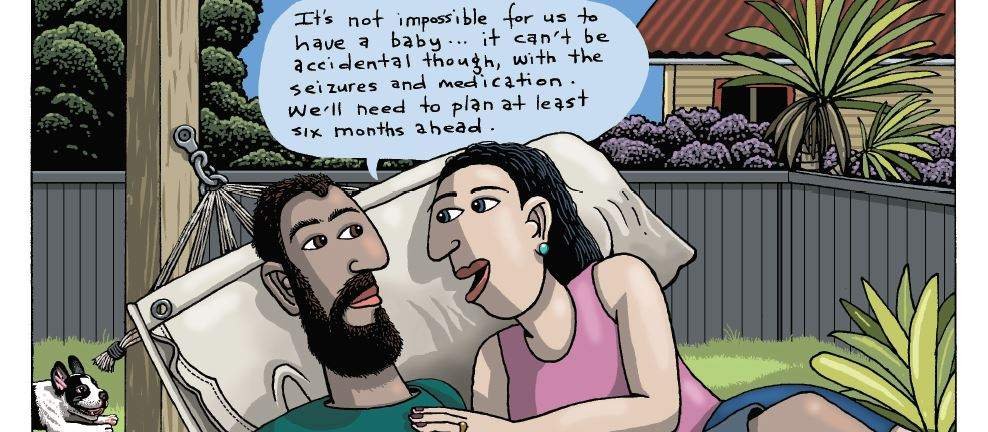Respiratory physician Lutz Beckert considers chronic obstructive pulmonary disease management, including the prevention of COPD, the importance of smoking cessation and pulmonary rehabilitation, and the lifesaving potential of addressing treatable traits. He also discusses the logic of inhaler therapy, moving from single therapy to dual and triple therapy when indicated, as well as other aspects of management
How to Treat: Epilepsy - assessment answers
How to Treat: Epilepsy - assessment answers

Below are the answers to the assessment from How to Treat: Epilepsy.
Record your score in the Capture box at the bottom of the page for your own records. Achieving 10 or more correct answers will allow you to claim the CPD credits/hours allocated to this course.
GPs: This “How to treat” has been endorsed by the RNZCGP and has been approved for up to 1 credit for continuing professional development purposes (1 credit per learning hour). To claim your CPD credits, log in to your Te Whanake dashboard and record this activity under the appropriate learning category.
Nurses: The College of Nurses Aotearoa (NZ) has endorsed this “How to treat” for 1.5 hours of professional development following completion of this assessment (CNA070).
1. Which TWO of the following are included in the International League Against Epilepsy’s definition of epilepsy?
b. at least two unprovoked (or reflex) epileptic seizures occurring more than 24 hours apart
e. one unprovoked (or reflex) epileptic seizure with a high probability of experiencing a second seizure (>60%)
2. Which TWO of the following terms are no longer used by the International League Against Epilepsy for classification of epileptic seizure types?
d. partial complex seizure
e. secondarily generalised seizure
3. Alan visits you after he lost consciousness while shopping earlier that day, while with his partner. She says the 34-year-old had twitching of both legs (and possibly arms) and his head was “hitting the ground”. It all lasted for about 15 seconds, after which he took a minute or two to return to full consciousness. This is the first time this has happened. Which of the following diagnoses is the most likely?
b. convulsive syncope
4. Belinda crashed her car after she lost consciousness on a long drive home one Sunday afternoon after visiting friends. The 19-year-old escaped with minor injuries, passed an alcohol breath test and no one else was hurt. Witnesses state the car left the straight, level highway and slipped into a ditch, having already slowed somewhat. What is the most likely cause of the accident?
a. driver fatigue
5. Which of the following tests used to investigate epileptic disorders is often performed after sleep deprivation to increase the likelihood of finding diagnostic abnormalities?
c. electroencephalogram
6. Which of the following anti-seizure medications is the best tolerated first-line choice for focal-onset epilepsy?
b. lamotrigine
7. Holly is a 28-year-old woman who has generalised epilepsy with tonic-clonic seizures. Which TWO of the following anti-seizure medications would be the most appropriate to consider as first-line therapy for her?
b. lamotrigine
c. levetiracetam
8. Holly, the 28-year-old patient with generalised tonic-clonic seizures, is started on lamotrigine. What THREE pieces of advice should she be given regarding contraception and pregnancy?
a. if she plans a pregnancy, she should see a neurologist six to 12 months before discontinuing contraception
b. lamotrigine dose and blood levels must be closely monitored if she becomes pregnant
e. depot medroxyprogesterone acetate injections or an intrauterine device (plus condoms) would be better options than oral contraceptives as they do not affect lamotrigine levels
9. All anti-seizure medications are associated with behavioural side effects. Which TWO of the following drugs have the highest risk of significant psychiatric adverse effects, including depression?
c. levetiracetam
e. topiramate
10. Driving is a difficult aspect of epilepsy management. Chris is 23 years old and has had two seizures this week after being seizure free for three years on medication, which he takes reliably and regularly. He has been under work stress and had poor sleep starting a month ago, but he is now sleeping better. Which TWO options are possible stand-down periods from driving that are applicable to Chris?
c. <12 months if a positive neurologist recommendation is obtained
d. 12 months, as laid out in NZ Transport Agency regulations for anyone experiencing a seizure
11. Preventable injuries and deaths during seizures are not uncommon. What is the most common cause of death brought about by seizures?
b. drowning
12. Sudden unexpected death in epilepsy is rare, but it is a concern for patients and families. Which THREE of the following are risk factors for SUDEP?
b. nocturnal seizures
d. tonic-clonic seizures
f. uncontrolled epilepsy




![Barbara Fountain, editor of New Zealand Doctor Rata Aotearoa, and Paul Hutchison, GP and senior medical clinician at Tāmaki Health [Image: Simon Maude]](/sites/default/files/styles/thumbnail_cropped_100/public/2025-03/Barbara%20Fountain%2C%20editor%20of%20New%20Zealand%20Doctor%20Rata%20Aotearoa%2C%20and%20Paul%20Hutchison%2C%20GP%20and%20senior%20medical%20clinician%20at%20T%C4%81maki%20Health%20CR%20Simon%20Maude.jpg?itok=-HbQ1EYA)
![Lori Peters, NP and advanced health improvement practitioner at Mahitahi Hauora, and Jasper Nacilla, NP at The Terrace Medical Centre in Wellington [Image: Simon Maude]](/sites/default/files/styles/thumbnail_cropped_100/public/2025-03/2.%20Lori%20Peters%2C%20NP%20and%20advanced%20HIP%20at%20Mahitahi%20Hauora%2C%20and%20Jasper%20Nacilla%2C%20NP%20at%20The%20Terrace%20Medical%20Centre%20in%20Wellington%20CR%20Simon%20Maude.jpg?itok=sUfbsSF1)
![Ministry of Social Development health and disability coordinator Liz Williams, regional health advisors Mary Mojel and Larah Takarangi, and health and disability coordinators Rebecca Staunton and Myint Than Htut [Image: Simon Maude]](/sites/default/files/styles/thumbnail_cropped_100/public/2025-03/3.%20Ministry%20of%20Social%20Development%27s%20Liz%20Williams%2C%20Mary%20Mojel%2C%20Larah%20Takarangi%2C%20Rebecca%20Staunton%20and%20Myint%20Than%20Htut%20CR%20Simon%20Maude.jpg?itok=9ceOujzC)
![Locum GP Helen Fisher, with Te Kuiti Medical Centre NP Bridget Woodney [Image: Simon Maude]](/sites/default/files/styles/thumbnail_cropped_100/public/2025-03/4.%20Locum%20GP%20Helen%20Fisher%2C%20with%20Te%20Kuiti%20Medical%20Centre%20NP%20Bridget%20Woodney%20CR%20Simon%20Maude.jpg?itok=TJeODetm)
![Ruby Faulkner, GPEP2, with David Small, GPEP3 from The Doctors Greenmeadows in Napier [Image: Simon Maude]](/sites/default/files/styles/thumbnail_cropped_100/public/2025-03/5.%20Ruby%20Faulkner%2C%20GPEP2%2C%20with%20David%20Small%2C%20GPEP3%20from%20The%20Doctors%20Greenmeadows%20in%20Napier%20CR%20Simon%20Maude.jpg?itok=B0u4wsIs)
![Rochelle Langton and Libby Thomas, marketing advisors at the Medical Protection Society [Image: Simon Maude]](/sites/default/files/styles/thumbnail_cropped_100/public/2025-03/6.%20Rochelle%20Langton%20and%20Libby%20Thomas%2C%20marketing%20advisors%20at%20the%20Medical%20Protection%20Society%20CR%20Simon%20Maude.jpg?itok=r52_Cf74)
![Specialist GP Lucy Gibberd, medical advisor at MPS, and Zara Bolam, urgent-care specialist at The Nest Health Centre in Inglewood [Image: Simon Maude]](/sites/default/files/styles/thumbnail_cropped_100/public/2025-03/7.%20Specialist%20GP%20Lucy%20Gibberd%2C%20medical%20advisor%20at%20MPS%2C%20and%20Zara%20Bolam%2C%20urgent-care%20specialist%20at%20The%20Nest%20Health%20Centre%20in%20Inglewood%20CR%20Simon%20Maude.jpg?itok=z8eVoBU3)
![Olivia Blackmore and Trudee Sharp, NPs at Gore Health Centre, and Gaylene Hastie, NP at Queenstown Medical Centre [Image: Simon Maude]](/sites/default/files/styles/thumbnail_cropped_100/public/2025-03/8.%20Olivia%20Blackmore%20and%20Trudee%20Sharp%2C%20NPs%20at%20Gore%20Health%20Centre%2C%20and%20Gaylene%20Hastie%2C%20NP%20at%20Queenstown%20Medical%20Centre%20CR%20Simon%20Maude.jpg?itok=Z6u9d0XH)
![Mary Toloa, specialist GP at Porirua and Union Community Health Service in Wellington, Mara Coler, clinical pharmacist at Tū Ora Compass Health, and Bhavna Mistry, specialist GP at Porirua and Union Community Health Service [Image: Simon Maude]](/sites/default/files/styles/thumbnail_cropped_100/public/2025-03/9.%20Mary%20Toloa%2C%20Porirua%20and%20Union%20Community%20Health%20Service%20in%20Wellington%2C%20Mara%20Coler%2C%20T%C5%AB%20Ora%20Compass%20Health%2C%20and%20Bhavna%20Mistry%2C%20PUCHS%20CR%20Simon%20Maude.jpg?itok=kpChr0cc)